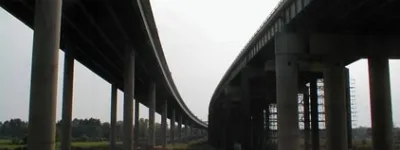Most towns have a ring road. It's something that brings great improvements to the local road network while not being too difficult to provide: there's no messy urban road building, just threading a road around the outside or, for a really cheap job, along wide suburban streets. Croydon didn't have that luxury. Already buried in the continuous sprawl of South London, any new road had to push its way through the houses.
The proposed ring road was more of a box. On the east side, Wellesley Road and the Croydon Underpass were to travel non-stop from Station Road to Barclay Road. To the south, the road was to be elevated across the Wandle valley from Barclay Road to Duppas Hill. In the west, Old Town and Mitcham Road were to be linked by a new railway bridge to create a link from Duppas Hill to Derby Road. And in the north, another underpass would complete the circuit from Derby Road to Station Road.
It is proposed to construct an underpass
As a result, Wellesley Road was made to temporarily narrow back down to a single-carriageway road at its northern end instead of having a proper terminal junction - an arrangement supposed to be swept away when the northern side of the Ring Road opened, but which still exists today.
By 1965 the first part of the Ring Road was finished, and it was time to look above ground, not below it.
The Croydon Flyover
Construction work started on the southern side of the Ring Road almost as soon as the concrete of the Underpass had set. Documents referring to this part of the route keenly described it as the Inner Ring Road Stage 2 (A), though as no other documents from the time have turned up, it's impossible to say whether they were also dreaming of an outer ring road or what Stage 2 (B) might have been. In any case, Stage 2 (A) was concerned with "Construction of a Flyover together with ancillary roadworks and structures between Friends Road & Duppas Hill".
While it formed part of the Ring Road, the Flyover had a dual purpose: it was also part of the designated East-West Route across the borough. The A232 follows this route (today it's the only primary route that comes close to Croydon town centre) and this is why the Flyover carries traffic right across the Duppas Hill Roundabout and away to the west instead of taking the more obvious course on to the west side of the Ring Road.
Opened in the late 1970s, the new route along Old Town, Roman Way and Mitcham Road formed the west side of the Ring Road, leaving just one part missing - the part that, vitally, would meet the main approach from London and relieve the northern end of the shopping area.
Nothing to see here
As it stands, the two trailing ends of the would-be Ring Road both see a broad, fast dual carriageway funnelled directly in to a narrow suburban street, with little relief for nearby residents and one of the busiest approaches to Croydon town centre missing out on any sort of road improvement whatsoever.
A word of warning
With thanks to Paul Rowntree for information on this page, and for kindly providing the diagrams of the Ring Road as a whole and the proposed northern side.
